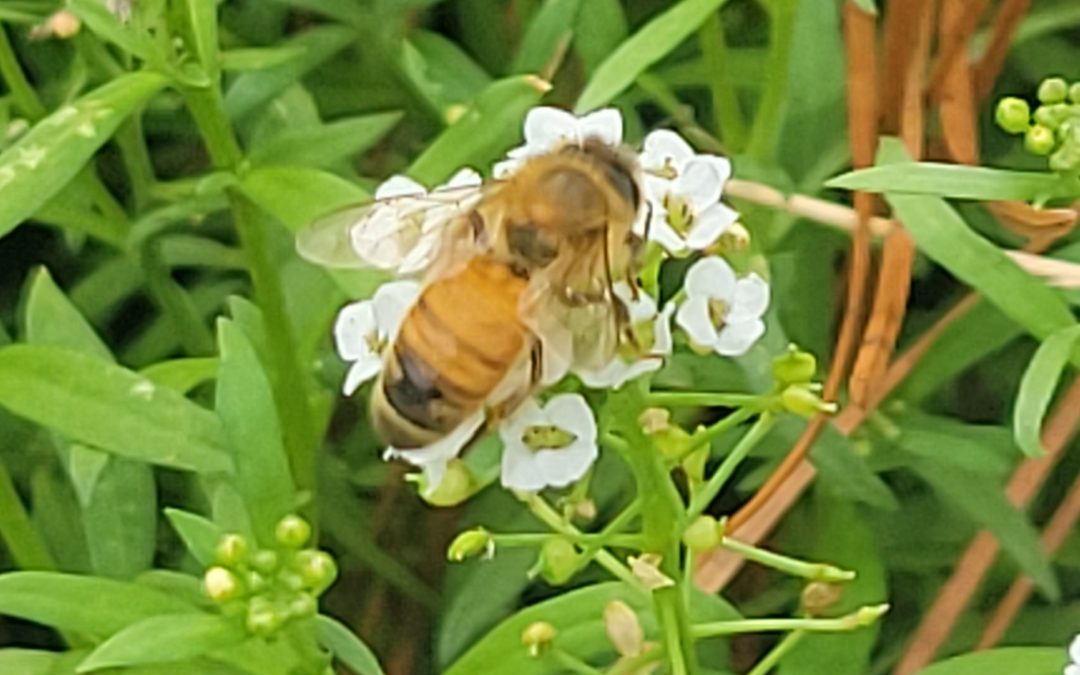
by Donna Arnold | Aug 10, 2022
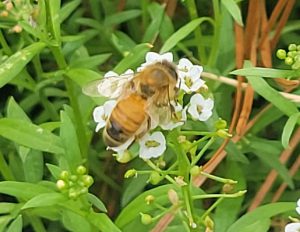 Introduction
Introduction
Summertime is known for cookouts, barbeque, a stroll through the park or even in your backyard; Be aware of stinging insects. These pests are especially active during the second half of summer and early fall when the colonies forage for food to sustain their queens during the winter. Although many are beneficial pollinators they often pose a danger because of their sting. While some of these stings causes minor reactions, others can pose a serious heath threat, which makes them medically important. These stinging hymenopterans includes wasps, hornets, yellow jackets, velvet ants, Africanized and European honey bee and fire ants.
Unique /Important Traits of this group of insects.

Photograph by Lyle Buss, University of Florida
Yellow jackets, paper wasps, and bald-faced hornets can sting multiple times causing allergic reactions. The female velvet ants have a very potent sting that has earned them the nickname “cow-killer.” Unlike Wasps, hornets, and yellow jackets, honey bees only sting once and lose their barbed stinger killing the bee within minutes talk about a sacrifice. Africanized honey bees are dangerous stinging insects that have been known to chase people for over quarter of a mile once they get excited and aggressive, earning the name “killer bee”. Imported fire ants both bite and sting repeatedly, and envenomation (injecting venom) only occurs through the sting.
Solitary vs. Eusocial
Most wasps and bees are solitary – being alone or in solitude, and do not defend their nests, but will sting in defense if caught. On the contrary, the eusocial group, especially ants, bees, and wasps, will display territorial behavior and it is mostly these groups that cause medically significant stings.
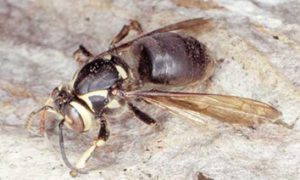
Photograph by James L. Castner, University of Florida
What makes Hymenopterans important medically?
Unlike the male, the female Hymenoptera possess specialized stinging apparatus used to inject their venom into prey’s or intruder’s body. Entomologist Justin O. Schmidt’s knows about this all too well, he records his own experience of venomous stings and rate it on a pain scale index ranging from 1- 4, with four being the most painful. It could be life-threatening for people sensitive to the venom. While most stings cause only minor problems, stings cause a significant number of deaths.
What are some possible reactions after the stings?
Local reactions (pain, small edema, redness at the site of the sting); regional reactions, (extensive local swelling, exceeding 10 cm, persisting longer than 24 hours). Systemic anaphylactic responses – most dangerous of the reactions. Symptoms may include itching, rashes or hives, tightness or swelling in the throat, stomach pain, nausea and vomiting and dizziness. More severe cases the individual may experience severe shortness of breath, a drop-in blood pressure, loss of consciousness. Even though some of these reactions are mild about 3% of people ends up the emergency room each year from symptoms related to stings. Some may result in death of the individual.
Treatment/ Preventative Measures
What to do?
Capture the organism, if possible, for identification; allergy desensitization shots; sting removal; hive removal (certified handler); antihistamine (oral or parenteral) and epinephrine by inhalation or epinephrine by injection.
For more information, please contact your local county extension office.
Supporting information for this article can be found in the UF/IFAS EDIS publications/websites below:
Differences Between European and African Honey Bees: IN784-9221465.pdf (ufl.edu); Stinging or Venomous Insects and Related Pests: IG099-D1czi7xu65.pdf (ufl.edu) ;
https://www.ncbi.nlm.nih.gov/pubmed/17265905
https://extension.entm.purdue.edu/publichealth/insects/stinging.htm

by Joshua Criss | Jul 14, 2022
The Case for Bats
Biological control is a pillar of integrated pest management. It may seem a bit daunting the principle is simple. All things in nature have predators including insects. Biological control is simply building a conducive environment for the predators of undesired pests. One animal not often thought of in this capacity is bats. Insectivores by nature, these underutilized creatures have a big impact to your open spaces. Their steady diet of moths (Lepidoptera), beetles (Coleoptera) and flies (Diptera, which includes mosquitoes) reduce insect pressure to your gardens and landscaping.
I know what you are thinking. How effective can they possibly be? Pregnant females consume up to two thirds of their body weight through the summer months while rearing pups. Bats are small but keep in mind that these are not solitary animals. In south Texas, a single large colony consumes enough insects to save cotton farmers an estimated $741,000 per year in insecticides. That is just to illustrate the point as you won’t be able to attract huge colony. There is no reason to believe a smaller colony will not provide similar services in your gardens.
Habitat
Now that your interest is piqued, how can you attract bats to your property? Installing a bat house is the easiest way. They are typically a two foot by one foot structure holding single or multiple chambers in which bats roost. It provides shelter from predation and weather while providing a place to rear pups. Though commercially available they may be built at home with minimal cost. Place the bat house in a location with morning sun at least 12 feet off the ground. Ensure there is enough airflow around the house to keep them cool, but that the structure is watertight. Mount houses on poles next to buildings and you’ll have better success attracting residents. With everything in place, it is time to discover who will most likely be your new neighbor.
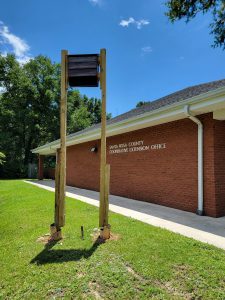
photo: Joshua Criss
The Bats of North Florida
Florida is home to 13 species of bats statewide. Of these, 11 may be found in the Panhandle but only 3 are common enough to be routinely seen. The Brazilian free-tailed bat (Tadarida brasiliensis) is the most common. Medium sized with brown fur, they have a long tail, wrinkled cheeks, and roost in man-made structures.

Photo: IFAS
Second most common are Evening bats (Nycticeius humeralis). These dark brown to yellow bats have short ears with a broad hairless muzzle. They are tolerant of other bat species often roosting in tandem with them.
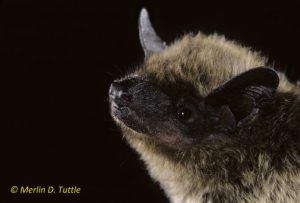
Photo: IFAS
Finally, the panhandle is home to Southeastern Myotis (Myotis austroriparius). Easily the smallest of these bats, they are dull gray to brown with a lighter belly and long hairs between their toes. This species is the bat most likely to eat mosquitoes.
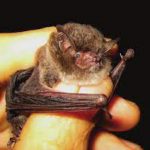
Photo: Jeff Gore, FWC
Finally, the panhandle is home to Southeastern Myotis (Myotis austroriparius). Easily the smallest of these bats, they are dull gray to brown with a lighter belly and long hairs between their toes. This species is the bat most likely to eat mosquitoes.
A Word of Caution
No article on wildlife would be complete without a word of caution. Bats are wild animals and should be treated as such. Never touch a bat on the ground as it most likely is not healthy. Bats do not generally cause issues but have been known to be disease vectors. Call a professional to collect the animal and never bring it into your home.
Bats can be a wonderful tool in controlling pests on your property. Creating habitat can help reduce pesticide need and cost to the homeowner. For more information on bats, see this Ask IFAS document, or contact your local extension agent for additional information on this and any topic regarding your gardens and more.
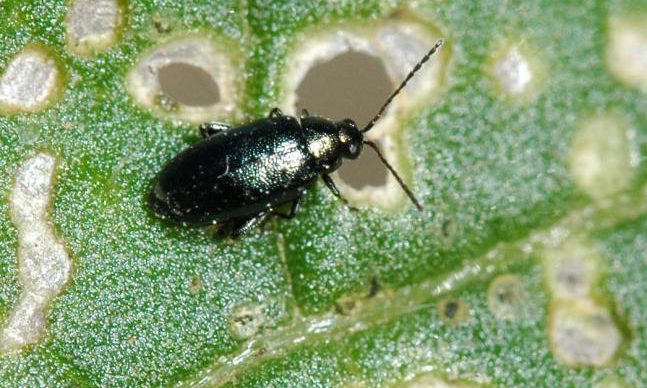
by Donna Arnold | Jun 9, 2022
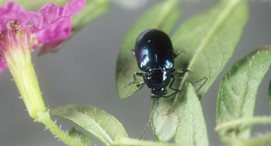
Photo credit Lyle J. Buss, UF/IFAS
The unwanted guest- Flea beetle
Having trouble with flea beetles? Tired of them showing up unannounced? Do not be alarmed here are a few tips to get rid of the unwanted guest in your garden.
Description: Flea beetles vary in appearance, where colors range from black to tan, with other, brighter colors mixed. They may also have a solid, striped, or spotted pattern depending on the species. Beetles are tiny with large hind legs which allow them to jump like fleas when disturbed.
Lifecycle: These unwanted guests will overwinter as adults in the soil or beneath plant debris and become active in early spring when temperatures reach 50°F, and begin feeding on weeds or early-planted crops. Eggs are laid by adult flea beetles normally around May in the soil or at the base of host plants. After 7-14 days eggs will hatch and larvae will feed and develop on various plant parts. They pupate in the soil for 11-13 days before emerging as adults.

Host plants: Some species attack a wide range of plants, while others target only certain plant families. (Table 1). In the garden, several vegetable crops are eaten by these pests, particularly those in the Brassica family.
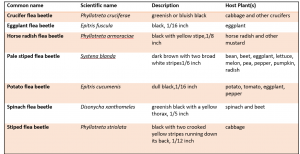
Table 1: Common flea beetles and host plants.
Scouting: Adult flea beetles are particularly active on warm, sunny days. To identify damages, scout every 1-2 days in newly planted fields, since it is easier to identify the damages than to see the beetles themselves. Flea beetle populations can be monitored with yellow sticky traps.
Damage: Adult beetles feed on foliage, producing shot holes in the leaves, especially new leaves which will have a lacy appearance. Additionally, in leafy crops like lettuce or spinach, the holes can reduce the quality of the leaves.
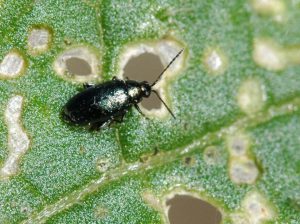
Photo Credits: Jeffery Hahn University of Minnesota
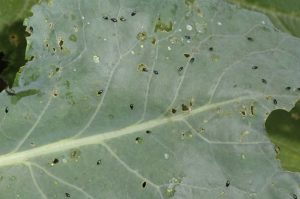
Photo Credit : Jeffery Hahn University of Minnesota.
Management / Control strategies:
- In the spring delay transplanting or planting by a couple weeks if possible.
- In the fall, till the garden to uncover any hiding flea beetles.
- Plant “push” or repellant crops such as catnip, sage, mint, hyssop, nasturtium, and basil.
- Use a “trap crop” such as radishes, taking the pest’ focus off more valuable plants.
- Dusting leaves with plain talcum powder repels flea beetles on tomatoes, potatoes, peppers, and other plants.
- Insecticides may be used early in the season.
- Water deters adult flea beetles. Any watering should be done in mid-day.
- Planting after adults have emerged or crop rotation can help minimize flea beetle damage.
- Apply commercially available nematodes that feed on flea beetle eggs, larvae, and pupae.
Supporting information for this article can be found in the UF/IFAS EDIS publications EENY-721/IN1238: Flea Beetles of the Genus Altica: Altica spp. (Insecta: Coleoptera: Chrysomelid) (ufl.edu); https://entnemdept.ufl.edu/creatures/ORN/BEETLES/flea_beetle.html and https://extension.uga.edu/content/dam/extension/programs-and-services/integrated-pest-management/documents/insect-pdfs/fleabeetles.pdf

by Larry Williams | Jun 9, 2022
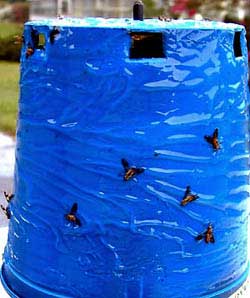
Deer fly trap. Photo credit: Russ Mizell
Recently, I’ve been asked about a deer fly trapping method that I wrote about a number of years ago. So, here it is. This aggravating insect is active now.
Deer flies, which are in the horsefly family, are annoying as they repeatedly and persistently dive for their victims until they inflict a painful bite.
Dr. Russ Mizell, now retired UF/IFAS Extension entomologist, experimented with a method to trap this insect. Mizell wanted to identify the optimum shape, size, color and speed to attract deer flies. If successful, he could temporarily remove a deer fly population long enough to enjoy an outdoor gathering without being bothered by deer flies.
Mizell said he started the research as a high school science project with his son but “it got so interesting, I just kept doing it.”
Deer flies wait for prey to walk before attacking. So, they are highly attracted to movement.
With this in mind, Mizell and his son decided the best way to snare deer flies was to “troll” for them from a slow-moving vehicle. Working in spring and summer when deer flies are most prominent, they set out to discover what kind of trap worked best.
They built a test platform on the hood of their vehicle that could troll seven different shapes at once. They ambled along in deer fly-infested countryside for set periods of one to five minutes, testing pyramids, squares, balloons, plant containers and other shapes, all coated with Tanglefoot (commercially available sticky spray for insects), then counting immobilized prey. They tried black, tan, blue and shapes of other colors suspended from various heights.
The trap that enticed the most deer flies proved to be a 6-inch flowerpot painted bright blue and coated with Tanglefoot. This trap captured as many as 30 deer flies in a one-minute test. It worked best when suspended three to six feet above the ground and trolled no faster than 10 feet per second or about 7 miles per hour.
The traps are remarkably effective, Mizell said. “Many times, after running the traps through an area, we found there were no deer flies left,” he said. “You trap them out for a short period until they repopulate the area.”
The traps also work when attached to a baseball cap and trolled by the hat’s wearer. But instead of attaching a flowerpot to your cap, you could attach a blue drink cup painted with Tanglefoot.
Despite its effectiveness, its aesthetic appeal leaves something to be desired.
For more information including instructions and pictures of how to make a deer fly trap visit the below site. http://entomology.ifas.ufl.edu/pestalert/deerfly.htm

by Matt Lollar | Mar 24, 2022

Written by: Donna Arnold, University of Florida/IFAS Extension – Gadsden County
Have you ever noticed mounds of dirt popping up on your lawn, in your cattle pastures, and other places? You just might be experiencing an ant invasion. The Red Imported Fire Ant, (referred to hereafter as RIFA) came from South America in the early 1900s through the port of Mobile, Alabama. Today, they have spread across the US and have become a serious pest causing significant social, environmental, and economic impacts. RIFA mounds can be seen in well-manicured landscapes, but also can nest around tree roots and stumps, as well as under pavement, buildings, and indoor areas. Although RIFA do prey on flea larvae, chinch bugs, cockroach eggs, ticks and other pests, however the problems they create usually outweigh their benefits.
Lifecycle/description.

Red Imported Fire Ant. Photo Credit: University of Florida/IFAS
Size determines the lifespan of RIFA workers. Minor workers may live 30 to 60 days, media workers 60 to 90 days, major workers 90 to 180 days, and queens may live two to six years. Complete lifecycle from egg to adult takes between 22 and 38 days. RIFA are 1/8” to 1/4” long and reddish-brown or black in color.
RIFA usually respond rapidly and aggressively when disturbed. They clamp onto their victims with powerful jaws and sting repeatedly while injecting painful venom. The stings cause a burning sensation and itching blisters that can become infected. Although very uncommon, in severe cases, the stings can produce shock or cause death.
Where one can find RIFA
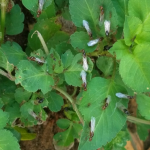
Winged alates preparing for nuptial flight. Photo Credit: Donna Arnold, University of Florida/IFAS Extension – Gadsden County
RIFA frequently invade home lawns, school yards, athletic fields, golf courses, parks, and other recreational areas. Additionally, electrical equipment and utility housing, home gardens, compost piles, mulched flowerbeds, pavement cracks, and the perimeter of bodies of water must all be considered when choosing a method of control.
Management
Two approaches can be taken to effectively manage RIFA.
- Single mound treatments
- Area-wide broadcast applications
Six methods of single mound treatment are available.
Mound Drenches. Large volumes of liquid toxic to ants are poured over a mound. Liquids can range from using several gallons of hot water to insecticides mixed with several gallons of water. This method may not reach the queen, therefore, not preventing colony elimination.
Surface Dusts. Similar to mound drenches, a dust or granular insecticide is applied over the top of the mound and then watered into the soil.
Mound Injections. The use of insecticides that may be pressurized and injected into a mound. Often this method is more expensive, but more effective, than mound drenches; however, more time may be required for this method.
Baits. Baits can be used for both individual mound and broadcast applications. A small amount of the bait is sprinkled around the mound and the ants then forage and bring the bait back to the colony to feed on. This method is slower acting, but more effective than drenching, dusting, or fumigating a mound because the workers will feed the bait to the queen and brood, thus gaining effective control of the colony.
Mechanical Control. Certain mechanical and electrical devices are on the market for controlling fire ants, but the efficacy has not been documented.
Home Remedies. Many homeowners will choose to pour boiling water or ignite flammable liquids over a mound. While these methods may bring about control, they are not recommended because they are both very dangerous, not only to humans, but also to the environment. Several other myths often circulate by the media or by way of word of mouth, often times these methods are anecdotal.
Area-wide broadcast applications
Currently, there are only a few products available for broadcast treatment of large areas. These products are either granular insecticides or baits composed of soybean oil and toxicant on a corn grit carrier. These granules are broadcast over a large area and are carried to the colony and fed to nestmates and the queen. This is a very effective application but does present problems because (1) ants may not find it, (2) do not feed upon the bait, and (3) some baits are light sensitive (as with hydramethylnon) and may inactivate before discovery by the ants. Reinfestation of any treated area, whether by broadcast treatment or individual mound treatment may occur.
As a result, other methods such as Biological Control is widely used to mitigate control of the RIFA.
Supporting information for this article can be found in the UF/IFAS EDIS publications (Managing Imported Fire Ants in Urban Areas) visit https://edis.ifas.ufl.edu/publication/lh059 and Red Imported Fire Ant, Solenopsis Invicta Buren (Insecta: Hymenoptera: Formicidae: Myrmicinae) https://edis.ifas.ufl.edu/publication/IN352.

by Molly Jameson | Oct 28, 2021

As you garden this fall, check out the North Florida Vegetable Gardening Guide, compiled by UF/IFAS Leon County Extension.
Getting into vegetable gardening, but don’t know where to start?
Even experienced gardeners know there’s always more to learn. To help both beginners and advanced gardeners find answers to their questions, the UF/IFAS Leon County Extension Office put together the North Florida Vegetable Gardening Guide. It incorporates multiple resources, including articles, planting calendars, photos, and UF/IFAS EDIS publications.
The North Florida Vegetable Gardening Guide covers the many aspects of vegetable gardening, including how to get started, site selection, insects and biodiversity in the garden, soil testing, composting, cover crops in the garden, irrigation, and more.
You can click here to view the digital version of the guidebook. We also have physical copies of the guide available at the UF/IFAS Leon County Extension Office (615 Paul Russell Rd., Tallahassee, FL 32301).
Happy fall gardening!























